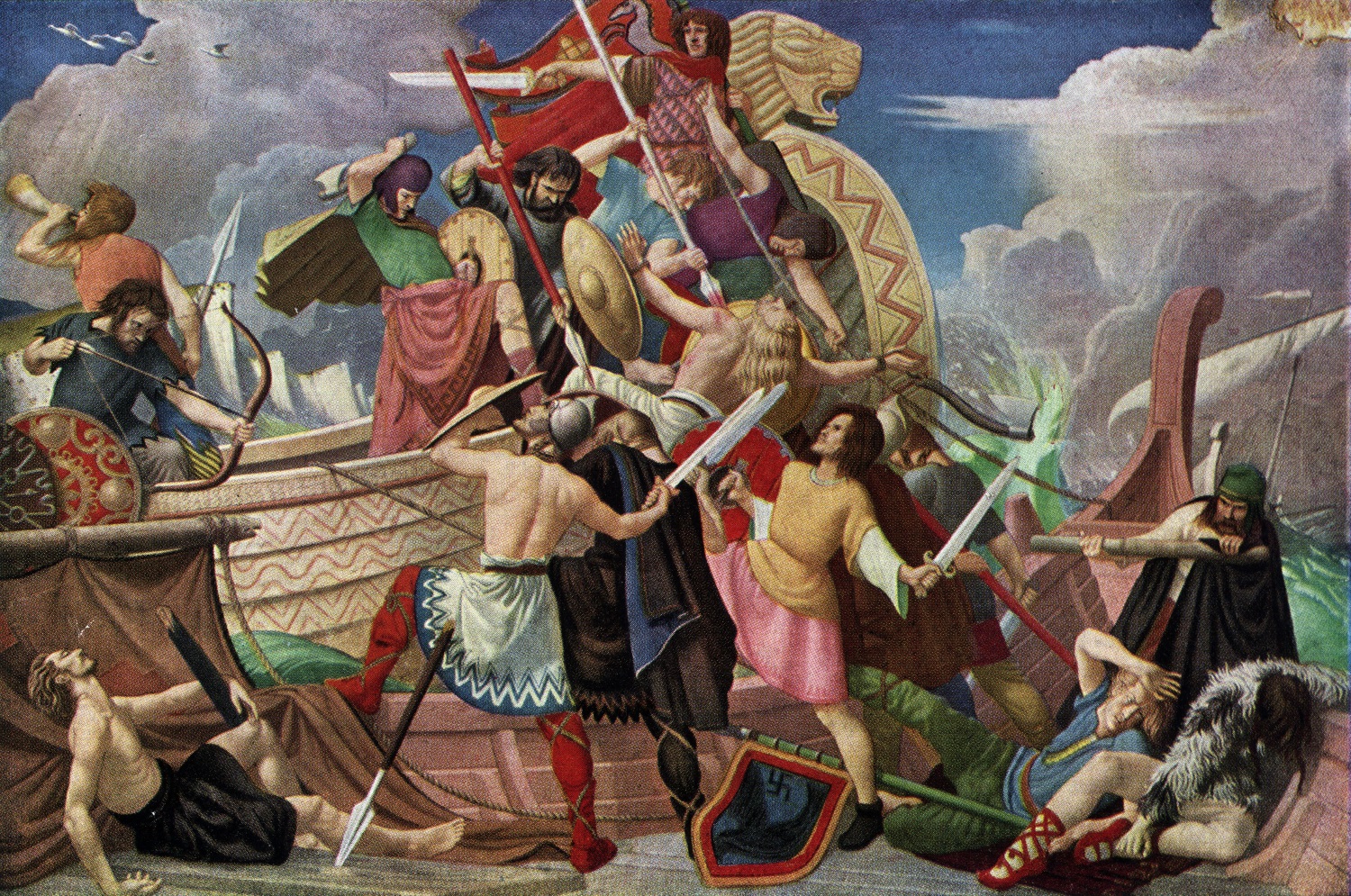In January 878, a band of men made their way through the Wessex countryside. Viking patrols searched for them, but the fugitives knew the hidden tracks and paths: this was their country. The man on the run was Alfred, and he was last king of the Anglo-Saxons.
The Viking age had begun in 793 with the sacking of the monastery at Lindisfarne, but by the second half of the ninth century, raiders were becoming conquerors. The Great Heathen Army landed in East Anglia in 865 and, led by the three sons of the legendary Ragnar Lothbrok, it had set about its task. Northumbria fell in 866 and East Anglia in 869; Mercia had been neutered as a fighting force in 867. In less than five years, three of the four Anglo-Saxon kingdoms had fallen – only Wessex remained.
The Vikings were masters of intelligence gathering. Their traders penetrated deep into Early Medieval societies, bringing back reports of the shifting political allegiances of the kingdoms of Europe. By 870, the leaders of the Great Army were well acquainted with the fact that Wessex was led by a young, untried king, Æthelred, who had only a younger and even less tried brother to succeed him.
Anglo-Saxon kingdoms were held together by oaths and personal obligations – kill the king, and the Vikings could reset these obligations in their own favour, either by installing a puppet or taking direct rule. For the magnates of Wessex, having witnessed the fates of the other Anglo-Saxon kingdoms, it must have seemed as if the Viking tide was inexorable. The wilier among them may have already been sending out feelers to the Great Army, inquiring as to the reward attendant upon a change of allegiance.
But first the leaders of the Great Army expedition, Halfdan and Bagsecg, had to show that they were serious – just how serious they were was demonstrated when they launched their attack in December 870. Winter was when men huddled by their fires; it was no time for war. But with the Wessex fyrd – the levy of free men and royal retainers that made up the kingdom’s army – having returned to their fields, winter allowed the Great Army complete freedom of action.
The Vikings made the most of it, sailing up the Thames to the royal estate at Reading. This estate held the food renders due to the king, thus providing ample stores for the Viking force. As was their normal practice, the Danes set about fortifying their base, constructing a rampart to defend the tongue of land they’d occupied at the confluence of the rivers Thames and Kennet, while having their boats dragged upon the strand ready to retreat, should that prove necessary.
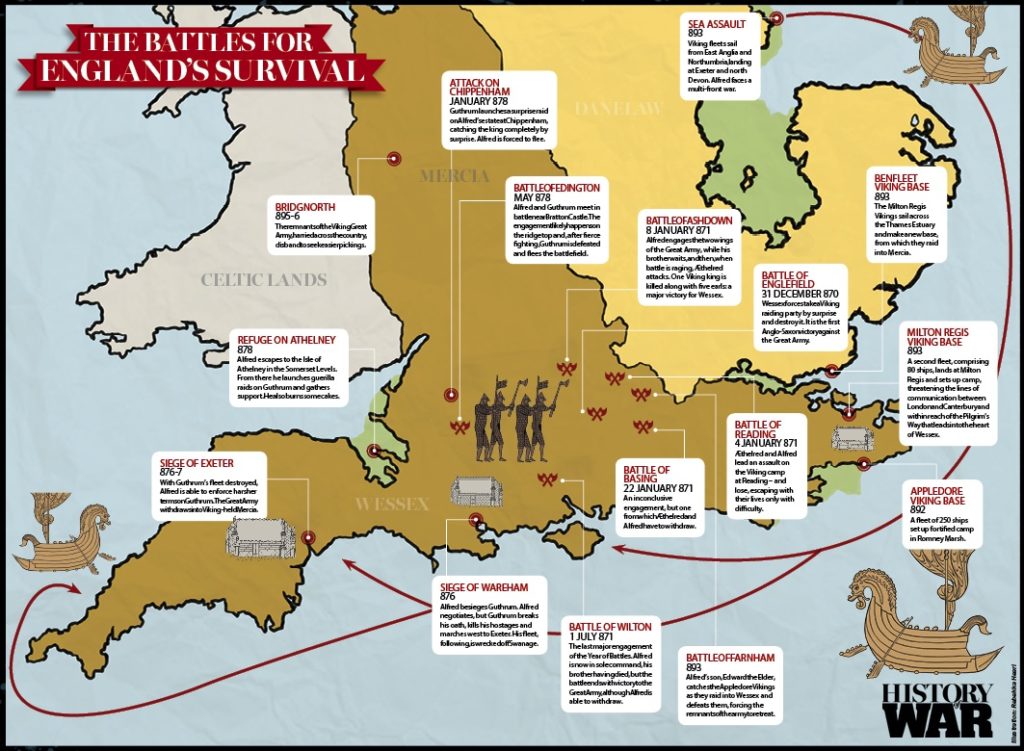
Wessex strikes
Given everything they’d learned in previous campaigns – when the Anglo-Saxon kingdoms took weeks to assemble their forces – Halfdan and Bagsecg could be forgiven for thinking they had time to finish digging in. The logistics of war were such that, even with the royal supplies, the Great Army needed to send out foraging parties. So three days after setting camp at Reading, Halfdan dispatched two Viking earls to plunder the surrounding countryside. But the men of Wessex were moving fast. The ealdorman of Berkshire had gathered his fyrd and, catching the foraging party in open countryside, he attacked. In the heaving, hacking scrum of the shieldwall, one of the Viking earls fell and, for the first time, the invaders broke and fled. The Battle of Englefield was won.
Although not much more than a skirmish, the Battle of Englefield was the first victory over the Great Army. Seeking to make the most of this, King Æthelred, with his brother Alfred, launched an attack on the Viking base at Reading.
This assault failed, and the royal brothers only just escaped with their lives. Now it was Halfdan’s turn to follow up his victory so, four days later, he marched his army from its base at Reading, heading west towards the royal estate at Wallingford. This was a resource that Æthelred and Alfred could not lightly give up. Approaching the Berkshire Downs, the Great Army split into two wings, one led by Halfdan and Bagsecg, the other by Viking earls, deploying along a ridge top in this landscape of long rises.
In response, the West Saxons also split their army in two, one wing commanded by Æthelred and the other by Alfred. The royal brothers were both devout and began the morning by hearing Mass. According to some sources, Æthelred remained afterwards to pray while Alfred left and, upon seeing he had to either attack or withdraw, charged ‘like a wild boar’ up the hill. This supposedly won Alfred a great victory.
If that seems unlikely, it’s because it is. What is likely to have happened is that the sources, all sponsored by Alfred, played down Æthelred’s part in the Battle of Ashdown. A more likely explanation of the battle is that the brothers deliberately planned for Alfred to engage both wings of the Great Army and then, when the shieldwalls were engaged and unable to manoeuvre, Æthelred would attack, catching the Viking army in its flank. It was a risky tactic, for it required Alfred and his men to withstand the Viking vice long enough to engage them completely before Æthelred could attack, and yet it worked.
The Great Army lost Bagsecg, five earls and many men, but the West Saxon losses were significant as well. Just two weeks later, the sides fought again, at Basing, but this time Æthelred and Alfred had to withdraw. The year of battles had seen five within a month, in the coldest part of the year. Through the rest of the winter, the war turned into a battle of logistical attrition, with the Vikings sending out foraging parties and Æthelred and Alfred leading patrols over the Downs to ambush them.
With spring, the fighting resumed in earnest. The other Anglo-Saxon kingdoms had cracked under Viking pressure, but Wessex was proving tougher. To cover the losses of the Battle of Ashdown, Halfdan called in reinforcements and by spring, they were in place, and the armies met at Meretun (the location of which has not been determined), with the Great Army the ‘masters of the field’. Halfdan was not able to kill Æthelred or Alfred, and the last few months had proved that so long as the West Saxons had leaders, they would fight. However, the Saxons were fast running out of leaders as, in April 871, King Æthelred died. Alfred, the fifth of five brothers, was now king at the age of 21.
The Vikings gathered further men when a ‘great summer army’ arrived and, with a young king on the throne, they made a further thrust into the heart of Wessex, meeting Alfred in battle at Wilton. Again, Alfred lost, but again the Vikings could not kill or capture him. For the Great Army, it was time to rethink the strategy. Alfred, for his part, desperately needed a chance to regroup and rest. So, representatives of the two sides met and thrashed out terms. Alfred, quite literally, bought himself time. In the autumn of the year of battles, the Great Army withdrew to London. The year had seen nine general engagements (not all recorded), the death of two kings, as well as many thegns and earls, but Wessex, and Alfred, still stood.
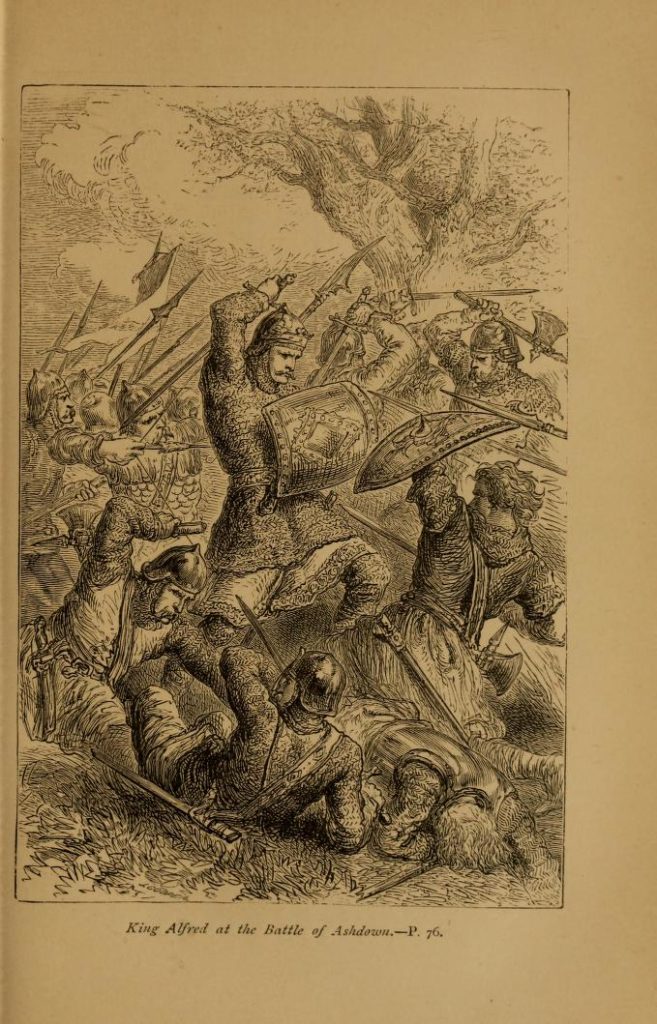
Alfred consolidates
The king had bought himself some time but, so far as the records indicate, he spent it by shoring up his rule of Wessex, tying the ealdormen (who ruled the shires in the king’s name) to him by giving gifts. For its part, the Great Army was employed over the next few years in putting down rebellions and then, finally, taking Mercia under direct control.
The Great Army also had a new leader. His name was Guthrum and he had led the ‘great summer army’ that had arrived on English shores in 871. When the time came to renew the assault on Wessex, Guthrum’s strategy showed that he had learned from the previous campaign. The preferred Viking strategy was to use river systems to sail into the heart of a kingdom, exploiting its political divisions. But while the Thames defined the northern border of Wessex, there were no easily navigable tributaries flowing into the heart of the kingdom. So, in 876, when Guthrum launched a fresh assault on the country, he attacked by land and sea simultaneously.
The Great Army had taken winter quarters in Cambridge but, at night and in secret, a land force, probably mounted, slipped from the town and rode at speed through the heart of Wessex to Wareham in Dorset. Here, Guthrum met a naval expeditionary force that had sailed around the coast from East Anglia. The Northmen set about fortifying their position, set between the rivers Frome and Piddle. As a back-up, Guthrum had also taken Brownsea Island in Poole Harbour, which commanded the entrance to the harbour and both secured his rear and allowed for a swift retreat should it prove necessary. Through this land and sea assault, Guthrum was sending a message to the magnates of Wessex: your king cannot protect you. With his lines of communication secure, all Guthrum had to do was wait, and Alfred knew it.
The warlords met. This was an era when conflict was personal: from the shoving scrum of the shieldwall to the face-to-face encounters of negotiators, men met their foes and took their measure. For his part, Alfred was confident he’d struck a deal with Guthrum: gold and hostages and the Viking’s oath, taken on his pagan gods, that he would leave Wareham. But Guthrum was after more than gold. He wanted a kingdom. Taking advantage of a slackening in Alfred’s siege, Guthrum escaped from Wareham, riding west, outpacing the pursuit. Guthrum left the hostages behind with their throats cut.
Guthrum rode to Exeter. The town lay on the edge of Dumnonia, one of the old kingdoms of the Britons that had only recently been subdued by the Anglo-Saxons. By taking Exeter, was Guthrum sending a message to the Britons, asking for their backing and allegiance in his war with Alfred? It is certainly possible, but before the old Brythonic nobility could throw their lot in with Guthrum, the Viking’s strategy was, quite literally, blown away. His naval forces, sailing to join him in Exeter, were caught in a storm and scattered, with as many as 120 ships lost.
It was time to talk… again. Alfred, in a stronger position, negotiated Guthrum’s withdrawal. Watching the Viking leader cross into Mercia, Alfred must have thought that he had weathered the second great assault on his kingdom, but although he had forced Guthrum’s retreat, he had not defeated him. Alfred only had one clear victory over the Great Army to his credit; little reassurance to the magnates of Wessex, who would lose everything should their young king fall. While Guthrum resupplied in Mercia, he sent emissaries into Wessex, targeting the ealdormen with an offer: join me, or at the least stand aside, and keep your land when a new king is raised.
It seems that at least one of Alfred’s ealdormen listened. Wulfhere, ealdorman of Wiltshire, was later stripped of his position and lands. With the king’s agent suborned, Guthrum was ready to make his move. Alfred and his household spent the Christmas of 877 in Wiltshire, at his estate in Chippenham. They remained there through the 12 days, unaware of what Guthrum was planning. Early in 878, he struck. Once again he moved at night, in winter, and he caught Alfred completely by surprise. Still at feast in Chippenham, Alfred heard that Guthrum was moving fast south towards him. With only his household about him, the king faced a stark choice: stay and fight – and die – or flee, sending the message that Guthrum wanted the magnates of Wessex to hear: their king was gone.
Alfred ran but he did not flee. Instead, he started working his way west towards the marshes of the Somerset Levels, a land he knew from boyhood, where he could find sanctuary amid the islets and channels. Safe in the levels, Alfred made camp on the Isle of Athelney and set about doing to the Vikings what they had been doing to the Anglo-Saxons for the last few decades: launching hit-and-run raids that kept the enemy off balance. In the art of mobile warfare, Alfred had been taught by masters. He also sent out messengers, summoning the men of the kingdom to rally to him.
In the seventh week after Easter (that is, between 4 and 10 May 878), Alfred rode from the marshes to Egbert’s Stone. He had summoned the men of Somerset, Wiltshire and Hampshire to meet him there. If they came, he would have an army. If they didn’t, his cause was lost. Luckily for him, he soon had his army.
Maintaining the pace, Alfred moved north at dawn the next day, while sending scouts to ascertain Guthrum’s position. For his part, Guthrum would have quickly heard that Alfred had emerged from the marshes. The Viking king was still in Chippenham and, with his enemy in plain sight, he did not hesitate. Guthrum marched out to meet Alfred, taking position near Bratton Camp, an Iron-Age hillfort on the western edge of Salisbury Plain. The fort, set on a ridge rising to 740 feet (225 metres) above the surrounding countryside, provided clear lines of sight to Alfred’s approach. A day later, they saw him – Alfred was approaching.
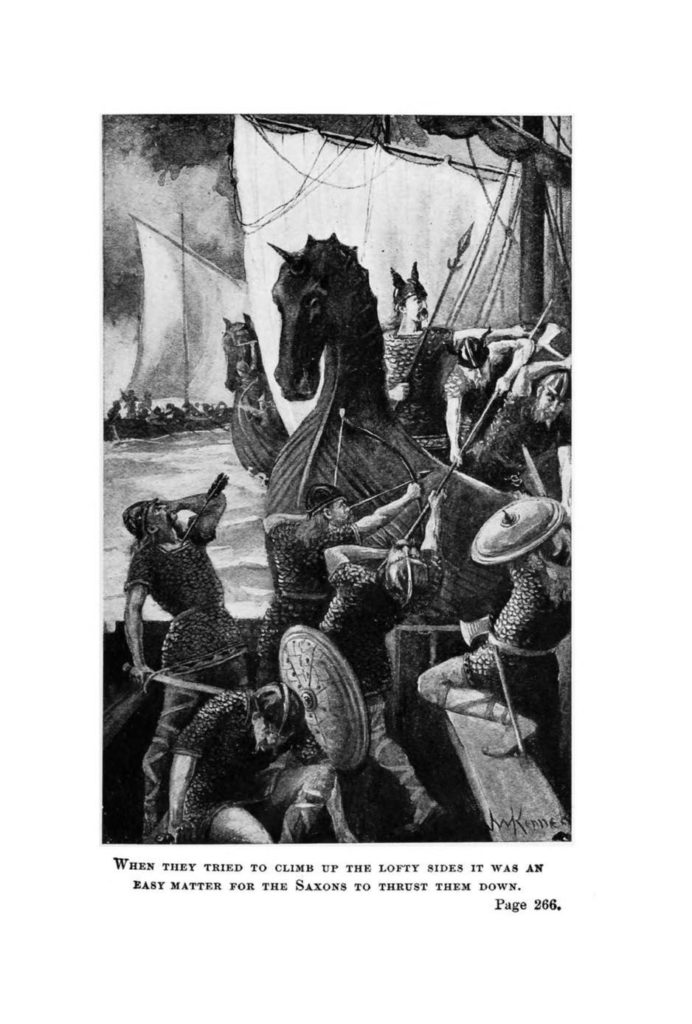
The fight for England
The Battle of Edington took place between 6 and 12 May 878. It may be the single most important clash in English history. A victory for Guthrum would have ended the last Anglo-Saxon kingdom. Today, we would most likely be speaking a derivative of Old Norse, and England, the land of the Angles, would never have come into existence.
The battle likely took place on the ridge of land in front of the hillfort. Setting his force there, Guthrum could ensure he was not outflanked – an important consideration as Alfred’s forces probably outnumbered his. But as Guthrum and the Northmen watched Alfred approach, they would have been confident: the Great Army had the better warriors and the confidence of its history.
Before the shieldwalls met, Alfred’s men threw spears that were designed to embed themselves in their enemies’ shields and weigh them down. Then, after insults and challenges, came the charge and clash, with Alfred and Guthrum each taking their places in the centre of their lines. Spears with leaf-shaped heads thrust for gaps. The shields themselves, with their heavy centre bosses, were as much for offence as defence.
The battle lasted for hours but, finally, Guthrum’s shieldwall broke. When this happened, defeat was usually swift and catastrophic – in fact, a mark of Alfred’s battlefield prowess was that he had suffered so many defeats and yet had managed fighting retreats that did not turn into routs: a major feat when he did not have ranged weapons to lay down covering fire. Guthrum, with a few men, fled, riding for his base at Chippenham. Leaving the majority of his army to finish off the stragglers, Alfred followed. This time, Guthrum was not going to escape.
Alfred laid waste to the area around Chippenham, and waited. 14 days later, starving and helpless, Guthrum and his remaining men sued for peace. Alfred could have taken and killed them all. Instead, he invited the pagan Vikings to accept baptism, and then to return to their lands with his gifts. Given Guthrum’s penchant for treachery, this might seem mad, but Alfred had a clear plan. By making Guthrum his spiritual son, he was drawing him into the Anglo-Saxon world, while maintaining a man now beholden to him as dominant in the Viking-settled parts of Britain.
Guthrum agreed, and he and 30 of his leading men were baptised, with Alfred standing as godfather to the Viking chief. After feasting and gift giving, Guthrum withdrew. Taking up the kingship of East Anglia, Alfred had regained his kingdom. But he knew the peace would not last. Next time, when the Vikings returned, he was going to be ready.
Having saved England, Alfred set about remaking it. First, he strengthened his ties with Mercia, which had for so long been a rival kingdom to Wessex, and by 883 he was its over-king. He tied the Mercians to him further by marrying his daughter to their governor and then, after re-taking London in 886, he tactfully returned the traditionally Mercian town to their control.
With this done, “[a]ll the English free of Danish rule gave Alfred their loyalty.” The king of the West Saxons was no longer a tribal ruler but the king of the English. A new nation was poised to emerge from the flames.
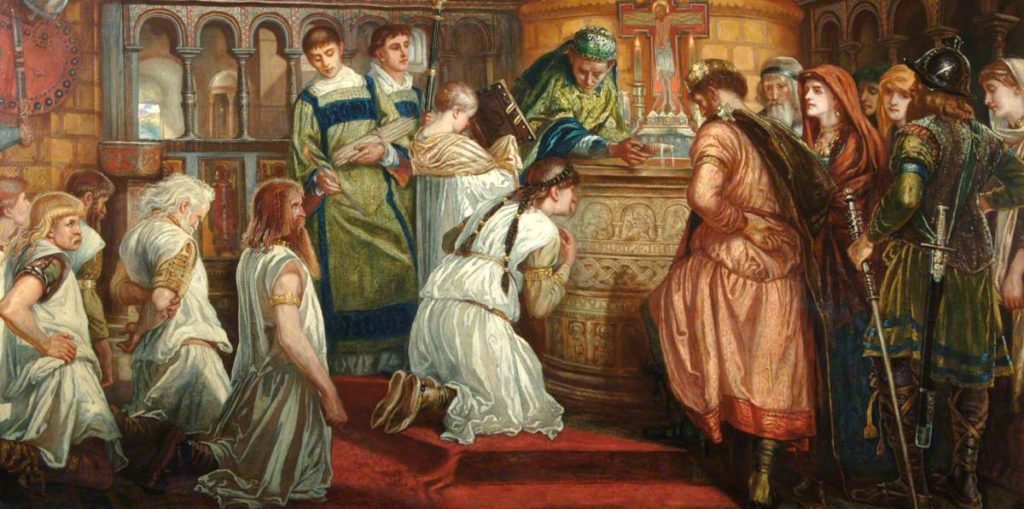
England survives
By the end of the 880s, Alfred had largely set up his new military organisation. Now it awaited the test. That came in 892. A fleet of 250 ships sailed up the River Rother and made a fortified camp at Appledore in Kent. The fleet carried families as well as warriors: this was a force intent on conquest. At the same time, a second fleet of 80 ships rounded Kent and made camp at Milton Regis, just south of the Isle of Sheppey. There were now Viking armies encamped on the north and south coasts of Kent.
Alfred responded rapidly, moving his field force to Kent and taking position between the two Viking bases, ready to pursue any breakout. Learning of his presence, the Vikings at Milton Regis negotiated, then sailed across the Thames estuary to make a new base at Benfleet in Essex. But a further Viking force had also assembled and, around Easter 893, sailed west along the Channel, raiding as it went. Making use of this distraction, the Appledore Vikings broke camp and launched a full-scale pillaging raid. Alfred faced a multi-fronted war.
Fortunately, his son, Edward the Elder, was now old enough to lead an army – he caught the plunder-laden train of the Appledore Vikings and defeated them at the Battle of Farnham, forcing the Northmen into a humiliating and booty-less withdrawal. King Alfred himself headed west to deal with the raiders along the Channel, who had landed at Exeter and north Devon. Meanwhile, men from Mercia and London launched an attack on the Viking base at Benfleet, burning the boats they found there and taking many captives.
But the Vikings were not defeated. There followed a confused series of campaigns, with the invaders from Benfleet crisscrossing the country, harried by Alfred’s ealdormen, while Alfred himself wore down the Vikings in Devon until they finally gave up and sailed for home. Late in 894, the Benfleet Vikings made a final attempt to wrest some gold and glory from their expedition, sailing into the Thames and then up the River Lea to Hertford. Alfred cut them off by building a double burh downstream. The Vikings were forced to abandon their boats and march west, to Bridgnorth, Shropshire, where, during 896, the army simply dribbled away.
Alfred had faced, and beaten, the largest combined Viking assault on Britain and he had done so not through a set-piece battle but by denying the Vikings the strategic advantages they had previously enjoyed. It was a vindication of his remaking of England.
In 899, Alfred died, and his son, Edward the Elder, and his daughter, Æthelflæd, Lady of the Mercians, continued his policies and strategic vision, gradually bringing the Danelaw under their control. Alfred’s grandson, Æthelstan, completed the task. England would be England after all.
Edoardo Albert is the author In Search of Alfred the Great: the King, the Grave, the Legend (with Katie Tucker) and Northumbria: The Lost Kingdom (with Paul Gething). His most recent book, the third part of his Northumbrian Thrones trilogy, Oswiu: King of Kings, is available now. For more on early Medieval warfare, subscribe to History of War for as little as £26.
